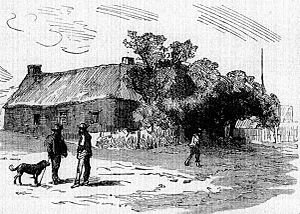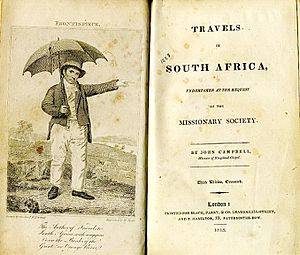Griqua coinage facts for kids
The Griqua coinage was the first special money made for a community in South Africa. It was started by the London Missionary Society, a group of missionaries.
Contents
History of Griquatown
Griquatown is a town in the Northern Cape Province of South Africa. It was first called Klaarwater. In April 1805, a missionary named William Anderson from the London Missionary Society founded the town.
A group of people, who sometimes called themselves Bastaards, were convinced by the missionaries to settle at Klaarwater. In 1813, John Campbell, a leader from the London Missionary Society, visited the town. He felt the name Bastaards was not nice. Campbell suggested they use the name Griqua instead. This name came from their old ancestors, the ChariGuriQua. During the same meeting, Klaarwater was renamed Griqua Town.
Griqua Life and Trade
Around 1780, early Griqua families moved from the northern part of the Cape Colony. They settled along the Orange River. Strong families like the Koks and Barends were central to the Griqua community.
Even though these families likely led the Griquas, other smaller groups also formed. A missionary agent named John Mellville studied these groups. He saw that one group grew from a few families to over 40 between 1817 and 1823. Other people also moved into the area. They claimed water sources and kept ties with the Griqua leaders.
The Griquas were very good traders. They understood how money worked. They acted as a link between the Cape Colony and the groups further north. Official trading happened at special fairs set up by the government. But they also often traded illegally with colonists.
Griquatown Coinage: The First Coins
The Griqua coinage was brought to Griquatown, South Africa, around 1817-1818. It was introduced by the London Missionary Society. These were the first known coins issued by Christian missionaries in South Africa.
The London Missionary Society called these coins "tokens." They were made in four different values:
- 1/4 pence and 1/2 pence were made of copper.
- 5 pence and 10 pence were made of silver.
At a meeting on August 7, 1813, they talked about many things, including money. They decided that since there was no small money for buying things like knives or scissors, they should ask the Missionary Society to make silver coins for them in England. These coins would have "Griqua town" on them. They hoped these coins would spread and be useful to all the people around.
At the Cape, there was a big shortage of small change in Griquatown and nearby areas. Griqua trade mostly involved swapping goods, using beads, or using a type of money called rixdollars. This situation likely made John Campbell suggest making special coins for the Griqua District.
Getting the Griquatown Coins Made
The London Missionary Society in London worked to get the coins made.
- In January 1816, a committee was set up to figure out how to get silver coins for Griquatown.
- In April 1816, they decided to spend £100 on silver coins to be used in Griquatown.
- In May 1816, the Society reported that an "Auxiliary Mission Society" was started in Griquatown. People there gave goods instead of money because money was not common. The Directors were getting silver tokens to help with this problem.
- In July 1816, they changed their minds and decided to send £200 worth of coins instead of £100. They called them "tokens" instead of "coins." This change might have been because of problems with the Rixdollar currency at the Cape.
- In October 1816, a payment of £191.12 was made for the "Silver Tokens."
- In December 1816, a man named Mr. Bateman was paid back for silver he lost. His boy was robbed of silver that was meant for the Griquatown tokens. He was paid £49 for this loss in January 1817.
Records also show that some Griqua tokens were sold to a collector for £3.8.0 before the main batch was sent to South Africa. This shows that the leaders of the London Missionary Society were very involved in getting these coins made.
Arrival in South Africa
On July 21, 1817, a letter was sent from Cape Town to David Langton. It said that two cases with small silver and copper coins had arrived safely. This letter is the only record that mentions the copper tokens arriving.
When John Campbell visited South Africa again, he wrote in his diary on August 8, 1820:
- He thought it was important to connect Griquatown with other towns.
- He also suggested asking the government to allow Griqua money to be used in other districts.
A few days later, on August 12, Campbell wrote that the Griquas would happily use the coins if they could be used in the Cape Colony. He promised to ask the Governor to allow this.
Were the Coins Used?
Heinrich Helm, a missionary in Griquatown, wrote a letter on June 21, 1821. He said that most of the Griqua money was still with the mission. He also mentioned that some silver pieces were given out at the wrong price. He asked what he should do with the rest of the coins.
This is the only record that talks about the coins being given out. It's not clear how their value was decided. Whether these coins were actually used by many people is still a big question for people who study old money (called numismatists). No records have ever been found that show the Griqua coins being used for payments.
Even so, the Griqua Coinage is very important. It was South Africa's first independent money and is a key part of the country's money history.
Quick Facts About the Griqua Coinage
Here's a summary of the main events:
- 1813: The idea for Griqua coinage was first discussed in August by John Campbell and the Griquas. The plan was for missionaries to use the coins as part of their pay and then use them to buy small items from the Griquas.
- 1816 (January): A committee was formed in London to make the Griqua coinage.
- 1816 (April): The committee decided to spend £100 on the coins. This amount was increased to £200 in July 1816.
- 1816 (October): A bill for £191.12 for the coinage was approved for payment.
- 1816-1817: Records show that some Griqua coins worth £3.8.0 were sold before the main shipment went to South Africa.
- 1817 (July): It was confirmed that both copper and silver coins arrived in South Africa.
- 1820 (August): John Campbell said he would ask the Cape Government to allow Griqua money to be used in the Cape Colony. He believed the Griquas would use the coins if this happened.
- 1821 (June): It was reported that most of the Griqua money was still at the mission station. Only a small part of the silver coins had been given out, and at the wrong value.
Coin Designs and Details
The Griqua coins had a special design. On the front (called the Obverse), they showed a dove flying with an olive branch. On the back (called the Reverse), they had the coin's value and the words "GRIQUA" (above) and "TOWN" (below and upside down).
The copper Quarter "Pence"
- Value: ¼
- Size: About 20.76 mm across.
- Thickness: About 1.33 mm.
- Weight: About 3.63 grams.
- Edge: Has vertical ridges.
The copper Half "Pence"
- Value: ½
- Size: About 24.86 mm across.
- Thickness: About 1.46 mm.
- Weight: About 6.20 grams.
- Edge: Has vertical ridges.
The silver Five "Pence"
- Value: IIIII (which means 5)
- Size: About 20.96 mm across.
- Thickness: About 0.66 mm.
- Weight: About 2.37 grams.
- Edge: Has slanted ridges.
The silver Ten "Pence"
- Value: 10
- Size: About 25.90 mm across.
- Thickness: About 1.06 mm.
- Weight: About 4.90 grams.
- Edge: Has slanted ridges.
Some test coins were also made, like a five and ten "pence" in copper, and a half "pence" in lead or copper with gold plating.
Images for kids








